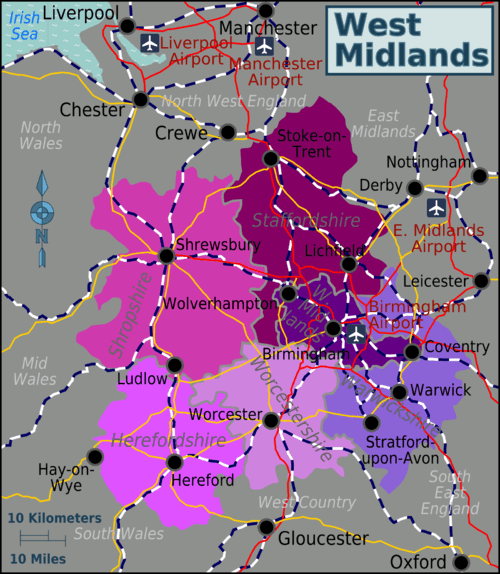West Midlands (region)
The West Midlands is the western part of central England in the United Kingdom. This central area borders North West England, the East Midlands, South East England, the West Country and all three parts of Wales (south, central and north). It is the only region of Britain and Ireland to lack access to the sea. While being heavily populated and industrialised, it retains much natural beauty in the rural areas surrounding the cities. Its main city, Birmingham, is the second largest in the UK.
Counties
The West Midlands region includes several traditional English counties as well as a central urban county called, confusingly enough, the West Midlands:

| Herefordshire sparsely populated (by English standards) pastoral hills centred on the cathedral city of Hereford |
| Shropshire hosts the birthplace of the iron industry - the quaint villages of Ironbridge and Coalbrookdale - Shrewsbury with many mediaeval buildings, and the Shropshire hills |
| Staffordshire Stoke-on-Trent, the area's main industrial centre, is known as "The Potteries" for its most famous industry; further south, historic Lichfield has a Gothic monster of a cathedral |
| Warwickshire Shakespeare's home in Stratford-upon-Avon, the attractive spa town of Leamington Spa and Warwick Castle |
| West Midlands County urban hub containing the conurbation of Birmingham, Wolverhampton and several other towns; also in this area is Coventry |
| Worcestershire the Malvern Hills form scenic countryside near the cathedral city of Worcester |
Other destinations
Understand
From around the 1870s until the 1970s, the region was "the workshop of the world", especially known for engineering, metal industries, beer production (due to the waters), and pottery from Stoke-on-Trent. There was also extensive coal mining. The centre of the industrial region, Birmingham, was known as "the city of a thousand trades" due to a vibrant free market in skills and an independent-minded population of workers. For complex reasons, this industrial base began to collapse from the 1960s onwards. Although much industry still remains, 100,000's of industrial factory-based jobs have been lost over the last 30 years.
The English counties that surround the urban core are still some of the most beautiful in England, especially Warwickshire, Worcestershire, most of north Staffordshire, and many parts of Shropshire.
Get in
By air
Birmingham Airport (BHX IATA) is the region's only major airport though Manchester, Liverpool and East Midlands airports are all less than 2 hrs from Birmingham. Of the London airports, Luton is the most convenient. It has hourly direct trains to Leicester and Nottingham that do not pass through London. To Birmingham takes about 2.5 hrs.
By car
Many of the UK's major roads converge on Birmingham. From the West Midlands: the M5 runs south west to Bristol and beyond; the M6 runs north via Manchester to Scotland; the southern part of the M6 heads into the East Midlands and connects with the M1 to provide access to London, which is also connected directly to Birmingham by the M40.
By train
Birmingham New Street sends out trains to all parts of the country and many major intercity lines pass through the region. London, Bristol, Liverpool, Nottingham and Manchester are each approximately 90 mins by train from New Street. Shrewsbury provides access to far-flung parts of South and Mid Wales via the "Heart of Wales Line" which runs south west to Llanelli near Swansea and the scenic "Cambrian Line" which runs west to Aberystwyth and Pwllheli. Holyhead's ferry port ensures that the north of Wales is well connected with the whole West Midlands.
Get around
The road network is extensive, if convoluted. There are also good bus and rail networks, as well as national cycle-routes and a large canal network for narrowboats.
See
- Shakespeare's birthplace Stratford upon Avon
- Some of England's finest castles in Warwick, Ludlow and Kenilworth
- Unique architecture of Birmingham's Bull Ring shopping mecca
- Industrial history including the world's first iron bridge in Ironbridge
Do
Eat
Birmingham is the home of the Balti cuisine, a much loved Anglo-Indian fusion created by 20th century immigrants from the Subcontinent to cater for local tastes. Despite its West Midlands origin, examples of this cuisine can now be eaten in curry-houses in almost every corner of Britain. Elsewhere, the town of Ludlow is renowned as quite a foodie destination. It has found a niche in high-end restaurants, and there is also a regular farmers' market and many delicatessens and other shops selling regional produce, allowing Ludlow to offer far more than expected for its small size.
Drink
Stay safe
Go next
- The North West's lively cities, Liverpool and Manchester, are only 90 min away from Birmingham
- The literature oriented town of Hay-on-Wye in Wales is most easily accessed from Hereford
- Cheltenham and Gloucester in the West Country and Oxford in the South East make for attractive short trips to the south
- London is very well connected to the region and is only 90 min away from Birmingham
- The Peak District, Britain's first national park, lies mainly in the East Midlands, though parts are close to Stoke-on-Trent